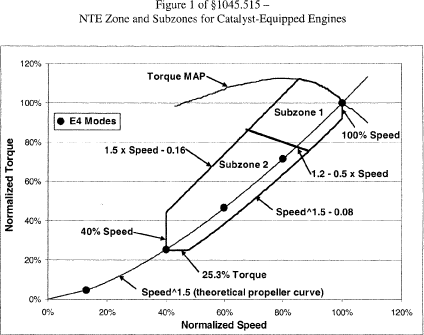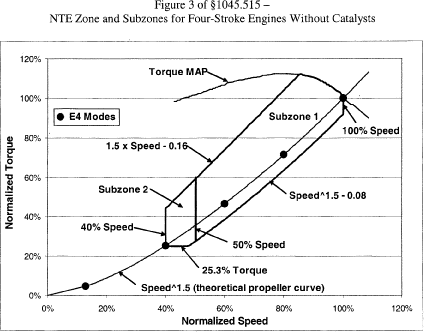Title 40
SECTION 1045.515
1045.515 What are the test procedures related to not-to-exceed standards
§ 1045.515 What are the test procedures related to not-to-exceed standards?(a) This section describes the procedures to determine whether your engines meet the not-to-exceed emission standards in § 1045.107. These procedures may include any normal engine operation and ambient conditions that the engines may experience in use. Paragraphs (b) and (c) of this section define the limits of what we will consider normal engine operation and ambient conditions. Use the test procedures we specify in § 1045.501, except for the provisions we specify in this section. Measure emissions with one of the following procedures:
(1) Remove the selected engines for testing in a laboratory. You may use an engine dynamometer to simulate normal operation, as described in this section.
(2) Test the selected engines while they remain installed on a vessel. In 40 CFR part 1065, subpart J, we describe the equipment and sampling methods for testing engines in the field. Use fuel meeting the specifications of 40 CFR part 1065, subpart H, or a fuel typical of what you would expect the engine to use in service.
(b) Engine testing may occur under a range of ambient conditions as follows:
(1) Engine testing may occur under the following ranges of ambient conditions without correcting measured emission levels:
(i) Barometric pressure must be between 94.0 and 103.325 kPa.
(ii) Ambient air temperature must be between 13 and 35 °C.
(iii) Ambient water temperature must be between 5 and 27 °C.
(iv) Any ambient humidity level.
(2) Engine testing may occur outside the conditions described in paragraph (b)(1) of this section, as long as measured values are corrected to be equivalent to the nearest end of the specified range using good engineering practice.
(c) An engine's emissions may not exceed the NTE standards in § 1045.107 under the following ranges of engine operation:
(1) The sampling period may not begin until the engine has reached stable operating temperatures. For example, this would exclude engine operation after starting until the thermostat starts modulating coolant temperature. The sampling period may also not include engine starting. For testing under paragraphs (c)(4) and (6) of this section, the NTE standards apply for any continuous sampling period of at least 30 seconds.
(2) Engine operation during the emission sampling period may include any nominally steady-state combination of speeds and loads within the applicable zone defined by segments on an engine's power vs. speed map specified in paragraphs (c)(3) through (6) of this section, except as follows:
(i) You may request that we specify a narrower zone, as long as the modified zone includes all points where your engines are expected to normally operate in use, but not including any points at which engine speed is below 40 percent of maximum test speed or engine load is below 25.3 percent of maximum torque at maximum test speed. However, we may perform valid tests at any speeds and loads within the zones specified in paragraphs (c)(3) through (6) of this section that we observe with in-use engines. The engine must comply with emission standards at all such speeds and loads unless we determine that one of following criteria are true:
(A) Such speeds and loads occur very infrequently. This determination may consider whether the operation would be expected to result in damage to the engine or vessel or be inherently unsafe.
(B) Such speeds and loads result from the engine being installed in a manner that is not consistent with your emission-related installation instructions.
(ii) You must notify us if you design your engines for normal in-use operation outside the specified zone. If we learn that normal in-use operation for your engines includes other speeds and loads, we may specify a broader zone, as long as the modified zone is limited to normal in-use operation for speeds greater than 40 percent of maximum test speed and loads greater than 25.3 percent of maximum torque at maximum test speed.
(3) The NTE zone for testing engines under this section is defined by the following segments on an engine's torque vs. speed map, as illustrated in Figures 1 through 3 of this section:
(i) Speed at or above 40 percent of maximum test speed.
(ii) Speeds and torques below the line defined by the following equation:
Normalized torque = 1.5 × normalized speed−0.16(iii) Speeds and torques at or below the engine's mapped torque values.
(iv) Speeds at or below 100 percent of maximum test speed, except as specified in paragraph (c)(5) of this section.
(v) Speeds and torques above the line defined by the following equation:
Normalized torque = (normalized speed) 1.5−0.08
(vi) Torques at or above 25.3 percent of maximum torque at maximum test speed, except as specified in paragraph (c)(5) of this section.
(4) For engines equipped with a catalyst, the NTE zone described in paragraph (c)(3) of this section is divided into the following subzones for determining the applicable NTE standards, as illustrated in Figure 1 of this section:
(i) Subzone 1 includes all operation in the NTE zone characterized by speeds and torques above the line represented by the following equation:
(percent torque) = 1.2−0.5 × (percent speed)(ii) Subzone 2 includes all operation in the NTE zone not included in Subzone 1.

(5) For two-stroke engines not equipped with a catalyst, the NTE zone described in paragraph (c)(3) of this section is divided into subzones for testing to determine compliance with the applicable NTE standards. Measure emissions to get an NTE result by collecting emissions at five points as described in this paragraph (c)(5). Calculate a weighted test result for these emission measurements using the weighting factors from Appendix II of this part for the corresponding modal result (similar to discrete-mode testing for certification). Test engines over the following modes corresponding to the certification duty cycle:
(i) Mode 1: Operate the engine at wide open throttle. For laboratory testing, this may involve any torque value between the boundaries specified in paragraph (c)(3) of this section.
(ii) Mode 2: Operate the engine at a nominal speed that is 80 percent of maximum test speed at any torque value between the boundaries specified in paragraph (c)(3) of this section.
(iii) Mode 3: Operate the engine at a nominal speed that is 60 percent of maximum test speed at any torque value between the boundaries specified in paragraph (c)(3) of this section.
(iv) Mode 4: Operate the engine at a nominal speed that is 40 percent of maximum test speed at any torque value between the boundaries specified in paragraphs (c)(3)(ii) and (v) of this section.
(v) Mode 5: Operate the engine at idle.

(6) For any engines not covered by paragraphs (c)(4) and (5) of this section, the NTE zone described in paragraph (c)(3) of this section is divided into the following subzones for determining the applicable NTE standards, as illustrated in Figure 2 of this section:
(i) Subzone 1 includes all operation in the NTE zone at speeds above 50 percent of maximum test speed.
(ii) Subzone 2 includes all operation in the NTE zone not included in Subzone 1.
 [73 FR
59194, Oct. 8, 2008, as amended at 75 FR 23020, Apr. 30, 2010]
[73 FR
59194, Oct. 8, 2008, as amended at 75 FR 23020, Apr. 30, 2010]